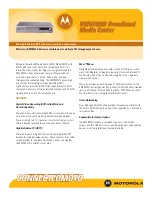
46
Quick Test for Remote Video
Vandalism
Tampering with cameras, the DVR or other hardware. This can be done by
damaging hardware directly or indirectly interfering (by spraying paint, fog or moving
objects in the way), or even through reconfiguration, using View software. Allow for access
to the DVR, if maintenance is required, yet prevent easy criminal tampering with the system.
Dew, frost or kitchen grease
Check camera lenses, or windows between the camera and
the subject for transparency and cleanliness.
Darkness
Without lighting or infrared cameras, indoor rooms and nighttime can make
cameras ineffective.
Cameras at an outside window
In a room that remains lit during evenings, reflection from
the window can hamper or block visibility outside.
Opaque objects
Even small objects can obstruct a camera when near, hampering an
operator’s view of a site. Large mobile objects, such as a truck also can be used to
compromise video of an event. Work around camera blind spots due to architecture, mobile
equipment, vehicle docking, construction and so on.
Power outage
Even when plugged into a UPS, a prolonged power outage compromises
the recording of video.
Calibrating Tamper Detection for Cameras
Calibration of tamper detection requires that a System Administrator has set up tamper
detection on a camera to trigger an alarm or to be logged, and that an operator use
LocalView or a remote operator use View.
Note
Tamper detection does not work the same way with IP cameras as it does
with analog cameras (described here). See documentation that came with
your Honeywell or supported ONVIF IP camera for more information. Refer to
the
Rapid Eye™ Hybrid HD and Hybrid LT Digital Video Recorders System
for more information on setting up tamper detection with
IP cameras in your Rapid Eye Hybrid LT system.
Blind
A camera can be blinded by too much light or too little. To calibrate, cover the
camera with an opaque cloth or box, or prop a strong light in front of the camera for more
than 48 seconds. Less time than this does not trigger an alarm or log entry. This amount of
time is designed to reduce the number of false positives. Check with the operator if an alarm
or log entry has occurred. Remove the opaque cloth. Turning the lights off at the scene can
also trigger tamper detection, as can panning a PTZ camera from a light colored scene to
a darker scene (or the opposite). Lowering the threshold can compensate. Blinding a
camera also triggers the Blur-type and Scene Change-type of tamper detection.
Blur
It is not recommended to alter a camera’s focus, once set. To simulate sabotage of
focus, use a lens-like sheet of glass or plastic, or a transparent container of water, and prop
it in front of the camera during calibration.
Summary of Contents for Rapid Eye Hybrid LT
Page 2: ......
Page 3: ...Installation Guide ...
Page 8: ...8 Contents ...
Page 10: ...10 Figures ...
Page 12: ...12 Tables ...
Page 24: ...24 Introduction ...
Page 66: ...66 Site Hardware ...
Page 70: ...70 Frequently Asked Questions ...
Page 84: ...84 ...
Page 85: ......
















































